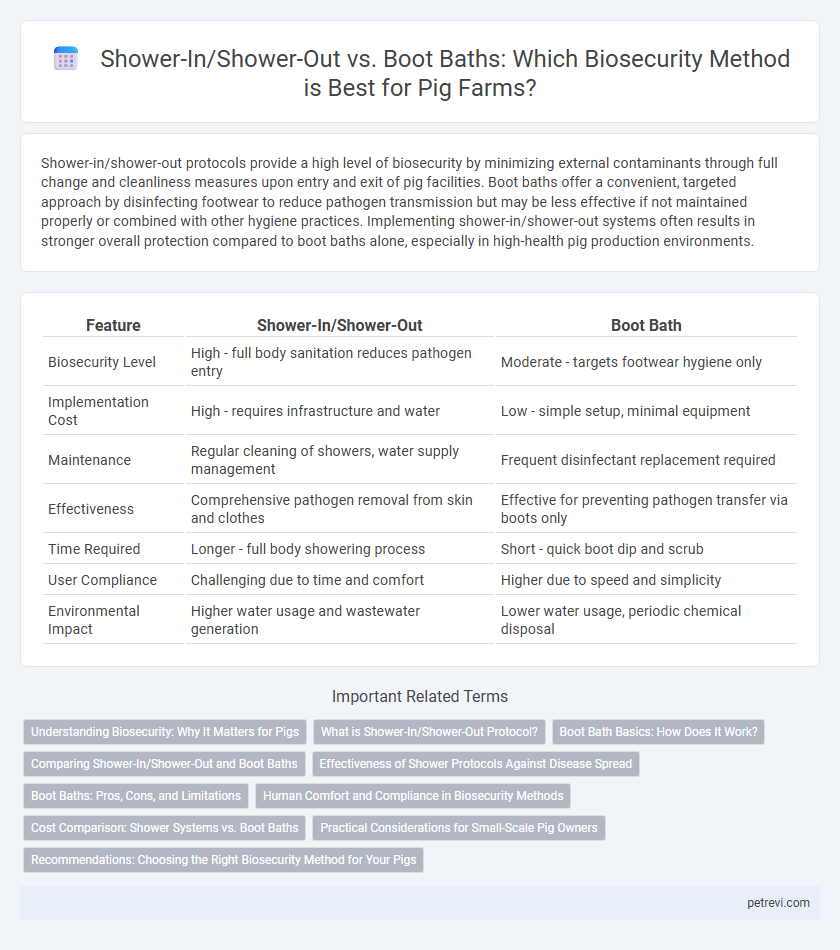Shower-in/shower-out protocols provide a high level of biosecurity by minimizing external contaminants through full change and cleanliness measures upon entry and exit of pig facilities. Boot baths offer a convenient, targeted approach by disinfecting footwear to reduce pathogen transmission but may be less effective if not maintained properly or combined with other hygiene practices. Implementing shower-in/shower-out systems often results in stronger overall protection compared to boot baths alone, especially in high-health pig production environments.
Table of Comparison
| Feature | Shower-In/Shower-Out | Boot Bath |
|---|---|---|
| Biosecurity Level | High - full body sanitation reduces pathogen entry | Moderate - targets footwear hygiene only |
| Implementation Cost | High - requires infrastructure and water | Low - simple setup, minimal equipment |
| Maintenance | Regular cleaning of showers, water supply management | Frequent disinfectant replacement required |
| Effectiveness | Comprehensive pathogen removal from skin and clothes | Effective for preventing pathogen transfer via boots only |
| Time Required | Longer - full body showering process | Short - quick boot dip and scrub |
| User Compliance | Challenging due to time and comfort | Higher due to speed and simplicity |
| Environmental Impact | Higher water usage and wastewater generation | Lower water usage, periodic chemical disposal |
Understanding Biosecurity: Why It Matters for Pigs
Shower-in/shower-out systems create a controlled hygiene barrier that significantly reduces pathogen transmission risks by requiring personnel to cleanse thoroughly before and after entering pig housing areas. Boot baths serve as a simpler biosecurity measure targeting footborne contaminants, but their effectiveness depends on regular maintenance and proper placement to prevent cross-contamination. Implementing rigorous shower-in/shower-out protocols alongside boot baths enhances overall biosecurity, safeguarding pig health and minimizing disease outbreaks within swine production facilities.
What is Shower-In/Shower-Out Protocol?
The Shower-In/Shower-Out protocol is a stringent biosecurity measure implemented in pig farming to prevent disease transmission between farms. It requires workers and visitors to wash and disinfect themselves thoroughly before entering (shower-in) and after leaving (shower-out) pig housing areas, minimizing pathogen transfer. This method is often favored over boot baths due to its higher effectiveness in controlling infectious agents such as Porcine Reproductive and Respiratory Syndrome (PRRS) virus and African Swine Fever (ASF).
Boot Bath Basics: How Does It Work?
Boot baths enhance pig biosecurity by effectively disinfecting footwear before entry into pig housing. The process involves stepping into a tray filled with a disinfectant solution that kills pathogens on boots, reducing the risk of disease transmission. Maintaining proper disinfectant concentration and regularly changing the solution are critical to ensuring the boot bath's effectiveness in preventing contamination.
Comparing Shower-In/Shower-Out and Boot Baths
Shower-in/shower-out protocols provide comprehensive biosecurity by minimizing pathogen transfer through full body decontamination, while boot baths target only foot hygiene, often proving less effective against diseases carried on clothing or skin. Studies indicate shower systems reduce contamination by up to 90%, compared to boot baths which show variable effectiveness depending on maintenance and disinfectant use. Implementing shower-in/shower-out alongside strict hygiene measures significantly lowers the risk of introducing infectious agents in pig production facilities.
Effectiveness of Shower Protocols Against Disease Spread
Shower-in/shower-out protocols significantly reduce disease transmission in pig facilities by minimizing pathogen transfer through clothing and skin. Studies indicate these protocols outperform boot baths by effectively removing contaminants from personnel entering and exiting pig housing areas. Maintaining strict adherence to shower procedures is crucial for enhancing biosecurity and preventing outbreaks of swine diseases such as PRRS and PEDV.
Boot Baths: Pros, Cons, and Limitations
Boot baths serve as a key biosecurity tool in pig facilities by reducing pathogen transmission via footwear, effectively targeting bacteria and viruses common in swine production environments. Their simplicity and cost-efficiency enable frequent use, but effectiveness depends on proper maintenance, adequate disinfectant concentration, and regular replacement to avoid contamination buildup. Limitations include reduced efficacy against certain pathogens, potential for cross-contamination if not managed correctly, and the inability to fully replace comprehensive biosecurity measures like shower-in/shower-out protocols.
Human Comfort and Compliance in Biosecurity Methods
Shower-in/shower-out systems enhance human comfort by providing a controlled hygiene process that minimizes the risk of pathogen transfer while ensuring compliance through mandatory complete decontamination before entry and exit. Boot baths offer a simpler, less time-consuming option but often face lower compliance rates due to discomfort from wet footwear and inconsistent disinfection effectiveness. Optimizing pig farm biosecurity relies on balancing effective pathogen control with practical, user-friendly methods that encourage consistent human adherence.
Cost Comparison: Shower Systems vs. Boot Baths
Shower-in/shower-out systems typically involve higher initial installation costs and increased water usage compared to boot baths, which are more cost-effective with lower setup and maintenance expenses. Operational expenses for shower systems include water heating and increased energy consumption, while boot baths require regular replacement of disinfectant solution to maintain efficacy. Despite these differences, shower systems provide superior biosecurity by fully cleansing personnel, potentially reducing disease outbreaks and associated costs in the long term.
Practical Considerations for Small-Scale Pig Owners
Small-scale pig owners benefit from shower-in/shower-out protocols by reducing pathogen transfer between outside environments and pig housing, promoting higher biosecurity standards. Boot baths require diligent maintenance and frequent solution changes to remain effective, which may be challenging for small operations with limited resources. Implementing shower systems ensures thorough sanitation but involves higher upfront costs and space requirements, making boot baths a more accessible yet less comprehensive option for farm biosecurity.
Recommendations: Choosing the Right Biosecurity Method for Your Pigs
Choosing the right biosecurity method for pig farms depends on farm size, layout, and risk level. Shower-in/shower-out systems provide comprehensive contamination control by requiring personnel to fully change and cleanse before entering pig areas, ideal for high-risk or large-scale operations. Boot baths offer a cost-effective, quick option for limited entry points but must be carefully maintained and combined with other measures to prevent pathogen spread effectively.
Shower-in/shower-out vs Boot bath for Pig biosecurity Infographic

 petrevi.com
petrevi.com